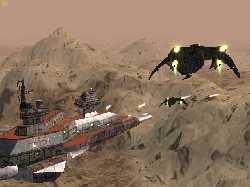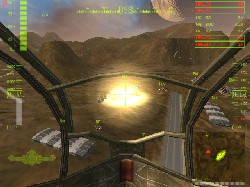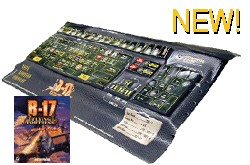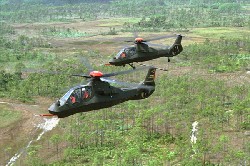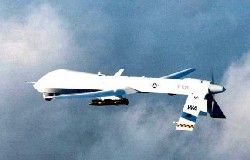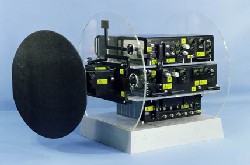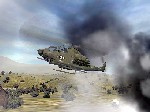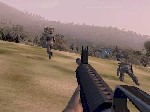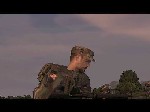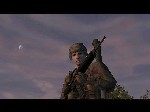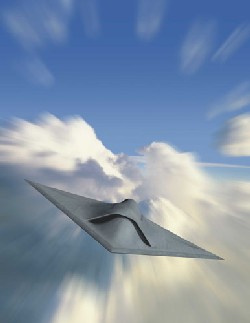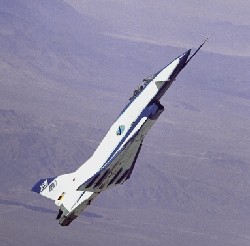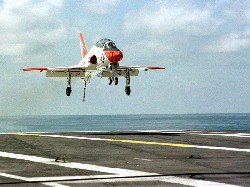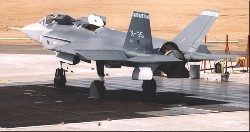Page 1
Daily News
By Gail Helmer
| Send Us News | Archives | Main |
Friday, March 2, 2001
PC News
- Ubi Soft to buy TLC, including SSI?
- Echelon Demo Released.
- Air Command 3.0 Demo Released.
- Keyboard Control Cover For B-17 2 Released.
- Flanker Version 2.5 CD Release Announcement.
- Jane's News Briefs
- First Pictures Of Civil War Sub's Interior Released.
Ubi Soft to buy TLC, including SSI?
COMBATSIM.COM has learned that Ubi Soft Entertainment, Inc. may be in the process of completing a surprise deal to acquire the entire games business of The Learning Co (TLC), including GAME Studios. If the rumour is true, then Strategic Simulations Inc. (SSI) (a division of The Learning Company) will be joining Blue Byte Software as the latest acquisition by Ubi Soft. (CSIM News Feb. 8th - Ubi Soft Acquires Blue Byte) What would this mean to the future of the "Digital Combat Series"? A Press Agent for GAME Studios told COMBATSIM.COM that TLC does not comment on rumors.
Echelon Demo Released.
Echelon puts the player in white-knuckle combat over lush alien landscapes and towering cities as a member of an elite fighting force facing a revolution on a colonial outpost. Featuring several branching campaigns and a well-wrought storyline, the player will have the ability to advance from Lieutenant to Commander during his/her battles and assume greater control over how each mission plays out. This demo is in Russian, an English version release is expected soon. Demo download available here: 3DFiles - Echelon Demo
Air Command 3.0 Demo Released.
Shrapnel Games announced today that they are releasing an updated and final demo for their upcoming game Air Command 3.0. Air Command 3.0 is a Windows 95/98 air traffic control simulator that puts you in the seat of an air traffic controller at a major international airport. The game is currently on track For a mid March Gold date. The new demo can be downloaded at Shrapnel Games
Keyboard Control Cover For B-17 2 Released
Control Zone Interactive Inc., the makers of Keyboard Control Covers that make PC games immediately playable, announced today the release of the cover for use with B17 Flying Fortress: The Mighty Eighth®. For more info go to: Control Zone Interactive
Flanker Version 2.5 CD Release Announcement
Matt Wagner, Producer/SSI, made the following announcement at Flanker2.com.
Given the large interest in the Flanker 2.5 upgrade by consumers unable to access the 80-megabyte download, we have joined forces with Electronics Boutique to distribute the Flanker 2.5 upgrade CD with existing boxes of Flanker 2.0. This low-priced bundle of approximately $20.00 will contain all the contents of Flanker 2.0 including the original V2.0 CD, a complete V2.5 CD, and the manual. We expect this to be available at EB by late March.
Given this extra time, we have included new training missions and an installation option that will enable owners of the earlier versions of 3Dfx Voodoo graphics cards to access higher resolution textures. We will also use this time to create an option to download the Flanker 2.5 upgrade as a group of several smaller files versus the single, large 80-megabyte file.
Although the V2.5 upgrade will be available for purchase with the boxed Flanker 2.0, we have every intention of making the upgrade available as a free download. The free download will not be made available until shortly after the Flanker 2.5/Flanker 2.0 bundle is on store shelves in late March. Thank you for your patience.
Matt Wagner
Producer
Game Studios / Strategic Simulations, Inc. (SSI)
Military News
First Pictures Of Civil War Sub's Interior Released.
Scientists released video pictures Friday of their first look 137 years into a historic moment of the United States' Civil War-era past. Scientists at the Warren Lasch Conservation Center in Charleston, South Carolina, released pictures Friday of the inside of the confederate submarine H.L. Hunley, the first sub to sink an enemy ship. The Hunley was built from an iron boiler and ran on human power. The Confederate sub sank February 17, 1864, after successfully torpedoing the Housatonic, which had been part of a Union blockade at Charleston Harbor in South CarolinaFull Story: CNN - Hunley
Thursday, March 1, 2001
PC News
- Flanker Version 2.5 CD Release Announcement
- NVIDIA Announces GeForce3 OEM Partners.
- ELSA Introduces The GLADIAC 920.
- AMD Athlon and Intel Pentium 4 Support GeForce3.
- Army's COMANCHE Helicopter To Attend AUSA.
PC News
Flanker Version 2.5 CD Release Announcement
Matt Wagner, Producer/SSI, made the following announcement this afternoon at Flanker2.com.
Given the large interest in the Flanker 2.5 upgrade by consumers unable to access the 80-megabyte download, we have joined forces with Electronics Boutique to distribute the Flanker 2.5 upgrade CD with existing boxes of Flanker 2.0. This low-priced bundle of approximately $20.00 will contain all the contents of Flanker 2.0 including the original V2.0 CD, a complete V2.5 CD, and the manual. We expect this to be available at EB by late March.
Given this extra time, we have included new training missions and an installation option that will enable owners of the earlier versions of 3Dfx Voodoo graphics cards to access higher resolution textures. We will also use this time to create an option to download the Flanker 2.5 upgrade as a group of several smaller files versus the single, large 80-megabyte file.
Although the V2.5 upgrade will be available for purchase with the boxed Flanker 2.0, we have every intention of making the upgrade available as a free download. The free download will not be made available until shortly after the Flanker 2.5/Flanker 2.0 bundle is on store shelves in late March. Thank you for your patience.
Matt Wagner
Producer
Game Studios / Strategic Simulations, Inc. (SSI)
NVIDIA Announces GeForce3 OEM Partners.
nVidia Corporation has announced that the GeForce3 graphics processor unit has secured design wins with top PC OEMs. In the coming months, the following PC OEMs and add-in card manufacturers will be offering products based on the GeForce3:
PC OEMS
Add-in Card Manufacturers
- Apple Computers
- Compaq Computer Corporation
- Dell Computer Corporation
- Hewlett-Packard Company
- Micronpc.com
System Builders
- ASUStek
- ELSA
- Gigabyte
- Hercules/Guillemot
- Leadtek
ELSA Introduces The GLADIAC 920.
- Atlas Micro
- Alienware
- ABS Computer
- Everex Systems
- Micro Pro
- Monarch Computer
Based on the highly-anticipated nVidia GeForce3, the ELSA GLADIAC 920 uses the new NVIDIA nfiniteFX engine and Lightspeed Memory Architecture to bring environments and characters to life. The nfiniteFX engine of the GeForce3 chip enables pixel-precise programming of realistic 3D effects such as volumetric and particle-based light, fog, smoke and explosion effects, textured material surfaces through reflective bump mapping and fantastically animated water surfaces. By combining the new Lightspeed Memory Architecture and 64MB DDR SDRAM with 3.8 ns access time and a 460MHz effective memory clock, the ELSA GLADIAC 920 provides outstanding 3D performance with 3.2 gigatexels per second. The ELSA GLADIAC 920 has a suggested retail price of $549.
AMD Athlon and Intel Pentium 4 Support GeForce3.
NVIDIA Corporation today announced that the new GeForce3 graphics processing unit has been optimized for Intel and AMD Athlon architectures. The new graphics accelerator, which will be available to consumers later this month, has been tuned to leverage the all-new Intel NetBurst™ micro-architecture as well as support Athlon features such as PC2100 Double Data Rate memory and 3Dnow! technologies.
"The NVIDIA GeForce3 provides an excellent, high-performance video option for AMD's processor customers," said Ned Finkle, director of the Infrastructure Enablement Group, AMD. "AMD has worked closely with NVIDIA to optimize the GeForce3 GPU drivers on the AMD Athlon processor platform to assure users will benefit from both performance and stability under extreme gaming and multimedia conditions. We feel that NVIDIA's use of DDR memory in the GeForce3 perfectly compliments the AMD Athlon processor's 266MHz front-side bus and DDR memory speeds
"Intel's Pentium 4 processor with its new Intel® NetBurst™ micro-architecture has been designed to accelerate operations on media and graphics rich content. We are pleased to have worked closely with NVIDIA so the GeForce3 can best take advantage of these capabilities. Together, the GeForce3 and the Pentium 4 processor significantly advance the visual realism now possible on the IA platform," said David Fair, Intel's visualization technologies initiative manager.
Military News
Army's COMANCHE Helicopter To Attend AUSA.
COMANCHE helicopter prototype No. 2 will be the centrepiece of the Association of the US Army (AUSA) Winter Symposium during the morning of Friday, March 2, 2001. Two RAH-66 COMANCHE prototypes in Florida flight test have completed more than 330 hours of flight to date, meeting all airspeed, vertical rate of climb, manoeuvre, slope landing and infrared signature test goals.
COMANCHE Prototype No. 2 will enter modification in May 2001 for Mission Equipment Package (MEP) flight test development and return to flight test status in December 2001. The December flight will include the Engineering and Manufacturing Development (EMD) core MEP with commercial displays and processors followed by the Night Vision Pilotage System in the second quarter of 2002 and the Target Acquisition System in the fourth quarter of 2002.
COMANCHE, which is considered the "Initial system of the Objective Force," has received significant support from Army leadership during the last several years and is on track for a 2006 Initial Operational Capability (IOC). Fielding COMANCHE is a key element of the Army's Transformation strategy leading to a more responsive and agile force to meet the challenges of the 21st century. The RAH-66 COMANCHE, the US Army's 21st century combat helicopter, is being developed by US Army Aviation and a team of leading aerospace companies headed by The Boeing Company and Sikorsky Aircraft Corporation, a unit of United Technologies Corporation. (Boeing Sikorsky Photo -- John Feaster)
Wednesday, February 28, 2001
PC News
- NVIDIA Introduces GeForce3 For The PC
- Hercules Announces 3D Prophet III.
- Guillemot Solidifies Its Presence In North America.
- MadOnion Releases 3DMark2001 Trailer.
- Predator Missile Launch Test Totally Successful.
- Air Force Issues Moratorium On Civilian Visitors Operating Equipment.
- Boeing Wins Contract To Support "Top Gun" And Strike Training Centers
- BAE SYSTEMS Delivers First Production Radar For Eurofighter
NVIDIA Introduces GeForce3 For The PC
Just 5 days after the original announcement for the Macintosh platform, NVIDIA Corporation announced the GeForce3TM GPU for the PC. The GeForce3 GPU is based on a radical new graphics architecture that will offer breakthrough graphics to multiple markets, including the desktop PC and the Macintosh® platforms. This groundbreaking GPU includes the same core technology as NVIDIA's highly anticipated Xbox GPU (XGPU) for Microsoft's XboxTM game console.
"Over the next several years we will create dramatic advances in 3D technology," stated Jen-Hsun Huang, president and CEO of NVIDIA. "Rich 3D graphics are the essence of a variety of digital appliances, from workstations to PCs to game consoles, like Microsoft's Xbox. The GeForce3 GPU represents a quantum leap forward in computer graphics and will redefine these platforms."
GeForce3's nfiniteFX™ engine includes hardware support for the vertex and pixel shading technology recently licensed to Microsoft for DirectX® 8. This breakthrough technology will dramatically change the visual quality and performance of Microsoft-based PC and console platforms.
"The short answer is that the GeForce3 is fantastic," said John Carmack, founder and chief programmer at id Software, Inc. "I haven't had such an impression of raising the performance bar since the Voodoo 2 came out, and there are a ton of new features for programmers to play with. Graphics programmers should run out and get one at the earliest possible time."
Hercules Announces 3D Prophet III.
Hercules has unveiled the 3D Prophet III. This latest graphic card from Hercules offers the nVidia GeForce3. Hercules optimized the board design and increased the stableness of its product with a customized cooling solution. Through Hercules 3D Tweaker 2.0 applicationn, gamers can adjust the card's settings according to their needs. The 3D Prophet III also offers DVD movie support with the included PowerDVD 3.0 application. The card will be available in March for about 530 USD.
"3D Prophet III illustrates Hercules’ strategy of always offering the best technology to match gamers expectations. By choosing NVIDIA’s new generation GeForce3 for our high-end card, we want to offer hardcore gamers the reference processor for new API and game enhancements," says Claude Guillemot, President of Hercules. "Our 3D Prophet III is a state of the art fragging device with the first fully programmable GPU providing full hardware optimization for new interactive environments and highly complex 3D animations." 3D Prophet III will be available in March for $ 529.99 (USD).
Guillemot Solidifies Its Presence In North America.
With only four years since it first opened its doors for operation in 1997, Guillemot Inc., continues to focus on the development of innovative technologies, ultimately aiming to bring the gaming industry in North America to new heights. Over the past two years, the acquisitions of the U.S established Hercules and Thrustmaster companies have permitted Guillemot to produce only the best in new graphic solutions and exciting accessories for console and PC. The company's recent consolidated net income of 7.1 million U.S., represented an increase of 81% from the previous financial year.
"Guillemot is committed to being the top producer of exciting accessories and hardware for gamers," says Alain Pakiry, V.P. Guillemot Inc. "We strive to be one of the top five gaming hardware and accessories manufacturers worldwide." "As the demand for PC and console accessories continues to become an ever-increasing part of the North American household, Guillemot Inc. will continue to hire the best engineers and marketing staff." Says Pakiry " We will continue to expand our operations to cater to the inevitable growth in the gaming market."
MadOnion Releases 3DMark2001 Trailer.
MadOnion.com released a 3DMark2001 trailer yesterday. It is available in both a high (12MB) and low (5.5MB) rez versions. You can get 'em here: 3DMark2001 Trailer
Military News
Predator Missile Launch Test Totally Successful.
Aerospace history was made recently with the successful launch of a live missile from an unmanned aerial vehicle. The Air Force's Predator Unmanned Aerial Vehicle program is evolving from a non lethal, reconnaissance asset, to an armed, highly accurate tank-killer, according to senior program officials from Air Combat Command at Langley Air Force Base, Va., and Aeronautical Systems Center here. "Capping a three-part series of demonstration flight tests on Feb. 21, Predator successfully aimed and launched a 'live' Hellfire-C, laser-guided missile that struck an unmanned, stationary Army tank on the ground at Indian Springs Air Force Auxiliary Airfield near Nellis AFB, Nev.," said Major Ray Pry, Predator program manager.
Flown by a pilot and sensor-operator from the 53rd Test and Evaluation Group at Nellis, who were located in a nearby Ground Control Station, Predator launched the missile using line-of-sight communication, inflicting heavy damage to the tank," Pry said. The final flight, part of the Phase I feasibility demonstration that began in August, was preceded by two similar, completely successful Hellfire launches, Pry said. "This first recorded missile launch from a UAV took place on Feb. 16," he said. "Equipped with a single, inert Hellfire-C missile, the Predator, using its line-of-sight communication band and infrared 'Kosovo' laser-ball, aimed and struck the tank-turret about 6 inches to the right of dead-center, spinning the turret around about 30 degrees. It made a big, gray dent in the turret -- just beautiful." (Courtesy Photo)
With the initial weaponization feasibility tests successfully completed, Gen. John Jumper, Air Combat Command commander will review the results to determine when Phase II will begin, said Lt. Col. Tom Carlson, director of ACC's advanced weapons requirements branch.
Air Force Issues Moratorium On Civilian Visitors Operating Equipment.
Falling in line with a Department of Defense-wide directive, the Air Force has issued a moratorium on permitting civilian visitors to operate any item of military equipment when such operation could cause, or reasonably be perceived as causing, an increased safety risk.
The moratorium is in effect while the Air Force conducts a top-to-bottom review of its policy relative to civilian visitors operating military equipment. Until such time as the review is complete, civilian passengers aboard Air Force aircraft are prohibited from manipulating the controls of the aircraft -- to include on-board systems such as air refueling booms.
This policy is effective regardless of how closely service members supervise the civilian visitors, said Air Force officials. Additionally, civilian visitors will not operate any Air Force equipment, such as small arms, shop equipment, aerospace ground equipment, specialized vehicles and any other equipment that requires training to operate, unless they have been specifically trained in the operation of such equipment. This does not mean civilian visitors can not ride aboard equipment, in concert with current Air Force instructions -- it only means they can not operate it, said Air Force officials.
Boeing Wins Contract To Support "Top Gun" And Strike Training Centers
The Boeing Company has been awarded a U.S. Navy contract to continue support for F/A-18 Hornet, F-14 Tomcat and SH-60 Seahawk aircraft at the Naval Strike and Air Warfare Center, including those used by the renowned "Top Gun" school. Work under the seven-year contract, valued at more than $150 million, will take place at Naval Air Station Fallon, Nev. Included in the contract is an option to support F-16 "adversary" aircraft that will be based at Fallon.
"This program is indicative of the comprehensive, affordable, customer-focused logistics services we can provide," said David Spong, president of Military Aerospace Support. "We are proud to be able to bring our capabilities to maintain this critical element of the Navy's advanced air-warfare training." Boeing Military Aerospace Support has provided comprehensive support for these aircraft through the Naval Tactical Air Warfare program since 1995.
BAE SYSTEMS Delivers First Production Radar For Eurofighter
BAE SYSTEMS has delivered the first production CAPTOR radar to the Eurofighter assembly plant at Warton in Lancashire. It is the first of 147 in the first tranche of production. The delivery, on time and to specification, marks the successful completion of the development programme, led by BAE SYSTEMS’ Sensor Systems Division at Crewe Toll in Edinburgh, as prime contractor of the Euroradar consortium. Euroradar comprises partners from the four nations in the Eurofighter programme, BAE SYSTEMS in Edinburgh, EADS in Germany, FIAR in Italy and INDRA in Spain.
The CAPTOR radar is the primary sensor of the Eurofighter aircraft providing unmatched air-to-air capability. The radar also has an extensive air-to-ground capability, which matches the aircraft’s "swing role" mission capability. Sensor Systems is currently populating its new £30m engineering facility at Crewe Toll, which has transformed the radar production area into one of the world's most modern and advanced.
CAPTOR project director, David Graham, said: "Today we have delivered a thoroughly mature product. CAPTOR has been extensively tested in the laboratory, in flight tests using our own aircraft flying from Edinburgh and in Eurofighter itself. Our unique test facilities allow us to analyse and understand the radar’s performance in the minutest detail. CAPTOR is performing beyond its specification and has been demonstrated to three potential export nations, in the air."
There is considerable export opportunity for Eurofighter. Norway, Singapore, The Netherlands and Korea are potential customers and Greece has recently agreed to purchase sixty aircraft with an option for thirty more. It is a unique situation that a foreign country has agreed to purchase a fighter aircraft before it is in service with the home nation. Eurofighter Sensor Systems project director, Frank Yuill, added: "This on-time delivery greatly enhances the prospects for export, in particular, to Greece. With planned upgrades and future developments we have a programme that has a lifespan in excess of 30 years." Eurofighter will enter Royal Air Force service in June 2002.(BAE Photo)
Tuesday, February 27, 2001
PC News
- Jane's / MicroProse Veterans Form New Company.
- Flanker 2.5 Delayed.
- Operation Flashpoint Screenshots.
- Price Drop On The Matrox Millennium G450.
- Northrop Grumman Unveils Unmanned Aircraft.
- X-31 VECTOR Programme Begins.
Jane's / MicroProse Veterans Form New Company.
Bill Becker, John Paquin, Max Remington, Chris (CJ) Martin, Frank Vivirito, Erroll Roberts, and Todd Brizzi have formed a new company called Cryophyte Entertainment, Inc. As a group, these folks have worked on the following titles:We are as excited as you are about this discovery and are awaiting word on what will be their first project. We'll keep you posted.
- Choplifter
- Pirates!
- F-19
- F-117 A Steath Fighter
- Civilization
- Railroad Tycoon
- NFL Coaches Club Football
- Taskforce: 1942
- Masters of Orion
- Darklands
- Fleet Defender
- 1942: Pacific Air War
- Virtual Karts
- Pirates Gold!
- Civilization II
- 1943: European Air War
- Magic: The Gathering
- Klingon Honor Guard
Flanker 2.5 Delayed.
Yesterday, at the Flanker2.com forum, SSI's Matt Wagner, Flanker Producer, announced that due to an as yet unresolved distribution situation Flanker 2.5 would be delayed. In the meantime, SSI will be putting this extra time to good use.
Operation Flashpoint Screenshots.
- Video Card Woes:Problems with Voodoo card owners seeing blurry textures will be solved. Because of problems with earlier Voodoo cards, the Flanker install would force Voodoo card users to the low resolution textures folder regardless of what version of Voodoo card they had. According to Wagner, what they plan to do in order to solve this problem is to have a dialogue box come up during the install that asks you what type of video card you have. If have a Voodoo card, the install when then give you a choice of choosing either Voodoo 1, 2, 3, 4 or 5. If your check Voodoo 1, 2, or 3, the install will copy all the medium resolution textures to the low resolution textures folder; if you check either Voodoo 4 or 5, the install will copy all the high resolution textures to the low resolution textures folder. Voila! Problem solved.
- Training Missions and Campaigns: Flanker 2.5 will come with new training missions, approximately a dozen new single-player missions, and one new campaign by Andrew Pavacic. Included in the training missions are airborne refueling, using the padlock, and using the KH-29 (both TE & L variants) air-to-ground missiles. Also of note, the original training missions that became unplayable during the upgrades from 2.01 to 2.03 will also be fixed. Because the additional training missions, single-player missions, and campaign represent approximately 150 - 200 MB of additional data, these will be offered as individual downloads separate from the main Flanker 2.5 download.
Codemasters releases new screens from the tactical action game in development at Bohemia Interactive.The new group of screenshots shows off some of the character faces and action featured in its upcoming tactical game Operation Flashpoint. The game takes place in the Cold War-era Soviet Union. Players assume the role of a NATO soldier on a peacekeeping mission, and they can advance in rank through the course of the game, depending on their success in its missions.
Price Drop On The Matrox Millennium G450.
Matrox Graphics Inc. announced that a price drop has been made on the Millennium G450. As of February 26, 2001, the Matrox Millennium G450 will be available for the reduced ESP price of $135 USD. The Matrox Millennium G450 is available for online purchase at the Matrox Shop
Military News
Northrop Grumman Unveils Unmanned Aircraft.
Northrop Grumman Corporation's Integrated Systems Sector (ISS) has unveiled its design for an unmanned aircraft that the company will fly later this year to demonstrate some of the technologies emanating from its new Advanced Systems Development Centre (ASDC) in El Segundo in California. A full-scale model of the Pegasus unmanned aerial vehicle (UAV) was rolled out of a hangar to culminate the opening ceremony for the centre. The actual vehicle, being built with company funds for the flight demonstration program, is expected to be completed this summer.
Artist's Concept of Pegasus
Designed with stealth features and shaped like a kite, Pegasus is built largely with composite materials. The aircraft measures 27.9 feet long and has a nearly equal wingspan of 27.8 feet. First flight is planned for the fourth quarter of this year at the Naval Weapons Centre at China Lake in California. One of the first tasks of the Pegasus flight programme will be to demonstrate the aerodynamic qualities of an autonomous UAV that would allow it to operate from an aircraft carrier. Northrop Grumman is performing trade studies, analysis and preliminary design for a naval unmanned combat air vehicle (UCAV) under a contract with the Defense Advanced Research Projects Agency (DARPA) and the US Navy. The goal of the joint DARPA/Navy project is to demonstrate the technical feasibility for a UCAV system to effectively and affordably conduct sea-based 21st century suppression of enemy air defences, strike and surveillance missions within the emerging global command and control architecture.
In addition to the naval UCAV, other unmanned programmes at the ASDC include the Watchkeeper tactical UAV for the British Army, the Navy Multi-Role Endurance UAV and the high-altitude Sensor Craft for the US Air Force. In manned aircraft systems, Northrop Grumman is conducting research on Future Strike Aircraft for the Air Force and on Quiet Supersonic Platforms for DARPA, the latter a study of supersonic military and commercial aircraft with a less intense sonic boom so they can operate over populated areas. The company also is working under a teaming arrangement with Orbital Sciences Corporation to help NASA define a safe, low-cost space transportation system.
Among the new centre's technical facilities are a Cyber Warfare Integration Centre, which can create simulations of advanced concepts in realistic environments, and a Systems Integration Laboratory that allows testing and evaluation of vehicle flight controls, mission systems and sensor integration concepts. The new centre houses approximately 500 employees along with laboratories and other technical facilities formerly located at other Northrop Grumman sites in Pico Rivera, El Segundo and Hawthorne in California.(Northrop Grumman Photo)
X-31 VECTOR Programme Begins.
The X-31 experimental aircraft is flying again. Last Saturday the maiden flight for the new test phase of the US-German VECTOR programme took place at the US Naval Aviation Flight Test Centre at Patuxent River in Maryland. The VECTOR programme objectives are to explore extreme short take-off and landing capabilities by using integrated thrust-vectoring control. VECTOR stands for Vectoring ESTOL (Extremely Short Take-Off and Landing) Control Tailless Operation Research. The record-breaking maneuverability and agility of the X-31 was already demonstrated in the first half of the Nineties with the Enhanced Fighter Maneuverability (EFM) program, which was the first and only international X-Programme in history.
X-31 at High Angle of Attack
Prior to the first VECTOR flight, several taxi trials had been performed in second half of January 2001 primarily to check the brakes and a laser monitoring system which controls take-off and landing of the X-31. The first flight test phase, scheduled for about six weeks, calls for the check-out of the aircraft systems and for the familiarisation of the US and German test pilots with the X-31. The VECTOR programme is jointly conducted by the US Navy and Boeing, and the German Federal Office for Defense Technology and Procurement (BWB), the German Air Force's Official Test Centre (WTD) 61, EADS Military Aircraft, and the Institute for Flight Systems Technologies of the German Aerospace Research Agency (DLR).
After the X-31 experimental aircraft had been transferred to "Patuxent River Naval Air Station late last year, the joint team integrated the new VECTOR-related aircraft hard- and software systems. Amongst these new systems was the Advanced Flush Air Data System AADS, developed by EADS Military Aircraft, the flight control software optimised for ESTOL applications, and a combined inertial/differential GPS platform for extremely high precision landing approaches. The new components enable the VECTOR demonstrator aircraft to cope with two operational challenges: approaching the runway at high angles of attack (up to 40 degrees) at low speed of around 100 knots. With such radical manoeuvres the pilot's vision is very obstructed, a fact that requires extremely reliable control and navigation systems.
Live ESTOL landings will be tested after completion of the current flight test phase and after implementation of a further update programme of the X-31 technology demonstrator. In particular the actuators of the deflectors for the thrust vectoring system will be modified for further fail-safe operation. The very first ESTOL test flights will prove the VECTOR principles at pre-defined safety height above the runway, with real landings to be performed at a later stage. In an additional VECTOR test phase the engineers will simulate Tailless Operation Research with a reduced or even totally removed tail fin by intense wind tunnel testing. The aim of the programme is to develop design parameters for an appropriate flight control system. (NASA Photo)
Monday, February 26, 2001
PC News
- eSim Games Terminates Agreement With Shrapnel Games.
- eTeam Releases Updated eRazor Patch.
- Remains Found of WWII Pilot.
- Plane Crash Kills Air Force, Navy pilots.
- JSF X-35B Begins Hover-Pit Testing.
eSim Games Terminates Agreement With Shrapnel Games.
Software developer eSim Games announced today that it has terminated its agreement with publisher Shrapnel Games and will instead sell its award-winning tank simulator, Steel Beasts, on the eSim web site (eSim Games ).
Al Delaney, owner of eSim Games, announced that orders for the game will continue to be taken online, but now from the eSim web site The company has also improved production quality and reduced shipping charges to better serve their customers. "We're shipping the latest version of Steel Beasts with an updated and expanded manual," Delaney said. "We think our customers will be very pleased with these improvements." Version 1.14 is the second update for Steel Beasts, which is a detailed PC-based simulator of the M1A1 and Leopard 2A4 main battle tanks. Each update has introduced new features as well as improved performance. Work on Steel Beasts 2 will begin shortly, with an expected completion date in the winter of 2001.
eTeam releases updated eRazor Patch.
1.0799.1 has been released. This release only fixes the serious bugs in 1.0799. It does not contain any new features. The release fixes the following:
Before downloading, make sure that you've read the readme. For more info go to: eTeam Website. To download the files go to the eTeam Download Section
- Fixed ApplyDamage CTD. Engine shutdown after getting damaged caused a CTD in certain situations.
- Fixed gun-routine for AI aircraft.
- Fixed Maverick FOV
- Fixed Aim-120 DLZ timer.
- Fixed SMS weapon selection. (Not being able to select inner hardpoints in some cases).
- Changed barcap limit from 17.5 nm to 30 nm
- Additional checks to prevent CTDs. - New crashhandler. Will help us better track where crashes occur.
Military News
Remains found of WWII Pilot.
The remains of a U.S. serviceman whose plane crashed in France during World War II were found last week in a northern French village. The pilot discovered near the wreckage of his fighter plane over 55 years after he crashed into a field in northern France may belong to a relative of General George Patton.
The airman’s remains were found by a local farmer and dug out of a clay field at La Longueville, between Maubeuge and Bavay where they had apparently lain undisturbed since his Mustang P51 plunged from the sky in 1944 or 1945. Metal identity tags found next to the body enabled officials to name the young pilot as William Patton. Personal effects, including the airman’s tie and leather jacket, complete with the insignia showing his rank of lieutenant were also found almost perfectly preserved.
The discovery was made on Thursday by local farmer Luc Druet, who recently decided to drain the clay soil in his field and had called in a team of experts to carry out the work. He was joined by Arnaud Bourriez, a 29-year-old local who had became obsessed with rumours that a fighter plane had crashed in the area towards the end of the war. "I knew, because several people had spoken to me about it, that a plane had crashed behind the old railway station," said Mr Bourriez. Mr Bourriez and Mr Druet first discovered a machine gun, before digging up pieces of the wreckage. "Then suddenly I saw white material, cords... it was the parachute," Mr Bourriez told the local paper, La Voix du Nord.
Nothing had burned during the crash and debris from the fuselage, the engine, propeller and the radiator were uncovered virtually intact. Armed with six machine-guns and powered by a V12 engine, the Mustang P51 only had room for the pilot. The police said US experts would try to determine whether the pilot was related to Gen George Patton.
The crash is surrounded by mystery. What caused the plane to plunge to the ground? Was the Mustang a victim of enemy fire or did it crash because of engine trouble or pilot error? The authorities want to find out if there were witnesses, did anyone go to the site of the crash, was the pilot’s body visible and if so, why was he not given a burial?
While the date of March 1944 is clearly marked on the parachute found next to the pilot’s remains, elderly residents of the village remember a plane crashing nearby while there was snow on the ground, leading gendarmes to believe that the Mustang probably crashed sometime that winter.
Following last week’s discovery, a local historian specialising in aviation, Jack Guillemin, has found that La Voix du Nord, in its edition of 17 January, 1945 carried a report of a US plane which had crashed in the region two days earlier. "On 15 January, at about 11:30am, at about 500 metres from the railway station at La Longueville, an American fighter plane, apparently lost in fog, crashed to the ground," read the article. (Source: Scotsman Online)
Plane crash kills Air Force, Navy pilots.
A T-45 Goshawk training aircraft crashed into, at approximately 4:18 p.m. Feb. 21, into the Atlantic Ocean off the coast of Florida killing two pilots, one Air Force and the other Navy. The body of Capt. Justin Sanders of the 33rd Training Squadron at Vance Air Force Base, Okla., was recovered, and Navy Lt. Gregory Fulco, a VT-22 instructor pilot at Naval Air Station Kingsville, Texas, was presumed dead when the search was called off because of darkness.
The crash occurred approximately 81 nautical miles from Mayport, Fla. Sanders and Fulco were performing safety observer duties about one nautical mile from the aircraft carrier USS Eisenhower (CVN-69). The Navy is investigating the incident.
The aircraft was temporarily assigned to a detachment based at NAS Jacksonville, Fla., where aircrews were performing aircraft carrier landing qualifications. The T-45A is a two place, high performance, fully carrier capable, training aircraft. It provides the Navy the capability to train student naval aviators for high performance jet aircraft and initial carrier qualification.
JSF X-35B Begins Hover-Pit Testing
The short-takeoff/vertical-landing (STOVL) version of the Lockheed Martin Joint Strike Fighter (JSF), the X-35B, has powered up its revolutionary propulsion system on a specially designed "hover pit" -- the first step in the STOVL portion of the aircraft's flight-test program. The X-35B is designed to demonstrate JSF requirements specified by the United States Marine Corps and the Royal Navy/Royal Air Force.
X 35A at Full Afterburner
"Running our propulsion system in the aircraft -- spooling up the engine, engaging the shaft-driven lift fan and commanding the vectoring nozzles -- is a big step toward validating our STOVL solution," said Tom Burbage, executive vice president and general manager of the Lockheed Martin JSF program. "We've operated this propulsion system very successfully on the test stand. Now we get to see how the airplane itself manages the interaction of the lift fan, three-bearing swivel duct and roll posts -- the system's main components."
During the tests, the airplane is fixed atop a ground-level metal grate over the hover pit -- a large rectangular basin with special ducting that pulls away the propulsion system's downward rush of air and engine exhaust. Inside the X-35B cockpit, Simon Hargreaves of BAE SYSTEMS, a veteran Harrier pilot, puts the propulsion system through every operation it will encounter during actual flight. Sensors determine if the aircraft's flight-control system is generating a proper mix of control forces from the propulsion system. Vertical thrust and control power are carefully measured.
The X-35B completed most of its up-and-away flight testing during the conventional-takeoff-and-landing (CTOL) X-35A's flight-test program last October and November. Both variants use the same airframe, and have identical external dimensions and up-and-away performance characteristics. The X-35A became the X-35B when the Lockheed Martin JSF team fitted it with the STOVL propulsion system in late December.
"The JSF is significantly larger than the Harrier, and our engineering studies concluded it would require a new STOVL propulsion approach," said Harry Blot, vice president and deputy program manager of the Lockheed Martin JSF, and a former Harrier pilot. "Our solution, the shaft-driven lift-fan propulsion system, greatly amplifies lifting power without straining the engine or compromising up-and-away flight performance."
Unlike traditional direct-lift STOVL systems that redirect hot engine exhaust, the Lockheed Martin system uses a drive shaft to connect the engine to a counterrotating lift fan, located immediately aft of the cockpit. The fan generates a column of cool air that produces nearly 20,000 pounds of lifting power, and combines with an equivalent amount of thrust from the downward-vectored rear exhaust to lift the aircraft. A smaller "roll post" duct in each wing supplies additional thrust and lateral control.
"We are now in the final stages of checkout testing prior to flight. These tests verify the propulsion system controls integrate with the aircraft, through all conditions," said Scott Winship, X-35 STOVL product lead. "We will perform conversion tests from CTOL to STOVL, where the lift fan is clutched in to bring the overall lift system on line. Other tests include throttle transients and control sweeps to measure the overall STOVL propulsion system response and thrust characteristics."
The lift fan, a patented Lockheed Martin design, was developed and produced by Rolls-Royce Corp. at its North American facility in Indianapolis. Also built by Rolls-Royce is the three-bearing swivel duct that vectors through 105 degrees to channel engine thrust during STOVL operations. The X-35's single Pratt & Whitney JSF119-611 engine, which shares its core design with the engines that power the F-22, is the source for the nearly 40,000 pounds of STOVL thrust.
Because the lift fan extracts power from the engine, exhaust temperatures are reduced by about 200 degrees compared to direct-lift systems, and exhaust velocity is also significantly lower. Combined with the low temperature and velocity of the lift-fan air, the result is a more benign ground environment.
| Send Us News | Archives | Main |
